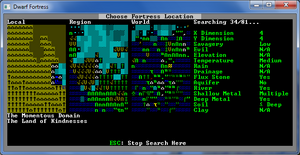- v50 information can now be added to pages in the main namespace. v0.47 information can still be found in the DF2014 namespace. See here for more details on the new versioning policy.
- Use this page to report any issues related to the migration.
Quickstart guide/Starting site
| This article was migrated from DF2014:Quickstart guide/Starting site and may be inaccurate for the current version of DF (v53.10). See this page for more information. |
v53.10 · v0.47.05 This article is about the current version of DF.Note that some content may still need to be updated. |
| This page is part of the Quickstart guide. It is intended for beginners and may not be a full reference.
This page has a more in-depth version here. |
Finding a Good Site[edit]
What sort of stone you have on your map is important, but you only know if you have soil, clay, a metal (ore), more than one metal, an aquifer, or flux stone. This makes things a challenge because it's harder to figure out what you're going to get for metals.
Aquifers[edit]
Heavy and varied aquifers may be extremely difficult to dig into as they constantly emit lots of water that can make mining difficult and potentially interrupt or even drown dwarves. This may limit the amount of stone and vertical depth you have to work with in the early game until you have a method of draining them. Light aquifers flood much more slowly, however, which makes it much easier to breach them and get through to the useful stones and ores beneath.
Aquifers of any type will need to be walled off to prevent flooding, which can be accomplished by either building or smoothing walls around damp stone. It is also possible to have areas that have no aquifers at all, which may be preferable for those who don't want to manage fluids in and around their fortress.
Trees[edit]
Also, you will want to avoid sites that have no trees. Dwarves like to sleep in beds, and beds are only made from wood. Also you need to be able to make charcoal, which requires wood. You could dig down to the first cavern level and chop down giant mushrooms for wood, but even the uppermost cavern level often contains far more Fun than a newbie can handle.
Water[edit]
Having a brook or river on your site will make things much easier. It isn't a necessity, as there are other sources of water on most maps, but only oceans, lakes, rivers, streams, brooks, aquifers and some cavern layers contain unlimited quantities of the stuff; and of these, rivers and brooks are by far the easiest to deal with. Speaking of water, take a look at the Climate. In temperate or colder climates, above ground water will freeze during the colder months. This can be anything from a minor inconvenience to a major pain, depending on circumstances. Just be aware that it is one more thing you will have to deal with, and choose your climate accordingly.
Hostile Civilizations[edit]
While searching your map for a good site, hit the Tab key to change the display. You will notice that there are several informative screens besides the default screen showing various properties of the area, including your Neighbors. A Neighbor is any Civilisation of a dominant race that would reasonably know about your new settlement and have diplomatic relations with the Civilisation you represent, which is selectable in the Your Civilisation tab.
Some Neighbors may be Towers, whose inhabitants are necromancers and the undead. You can be attacked at any time by undead armies if you embark near a Tower; those wanting for a slower experience may want to avoid these sites.
If any of your Neighbors appear with a red line, it indicates significant diplomatic hostilities between your Civilisation and theirs which most likely will lead into outright war. Open war will also be indicated in capitals. If any of these apply, especially for Goblin civilisations, expect a siege after your first winter. Sieges can be incredibly dangerous for young fortresses, but are entirely survivable with enough patience, and even defeatable with well-placed traps. Avoid overconfidence in your military, forbid and tightly close your doors, and hope the enemy dispel before your supplies of food, water, and raw materials run out.
Geography[edit]
It may also be helpful to choose a location with a solid cliff face and a decent mountain to dig into above ground, so that your fortress can have a more straightforward layout. It's also possible to ignore this and have a fortress that's entered from above, if you'd like, but some may find it easier to have all of the main parts of a fortress visible on one screen, to help facilitate an early understanding of how the fortress works.
Evil Biomes[edit]
Finally, you really, really do not want the surroundings of your first site to be "sinister", "haunted", or "terrifying". These areas are infested with aggressive, hostile creatures such as Undead versions of normal wildlife. Even experienced players may have trouble dealing with them, so it's best to avoid them for now.
